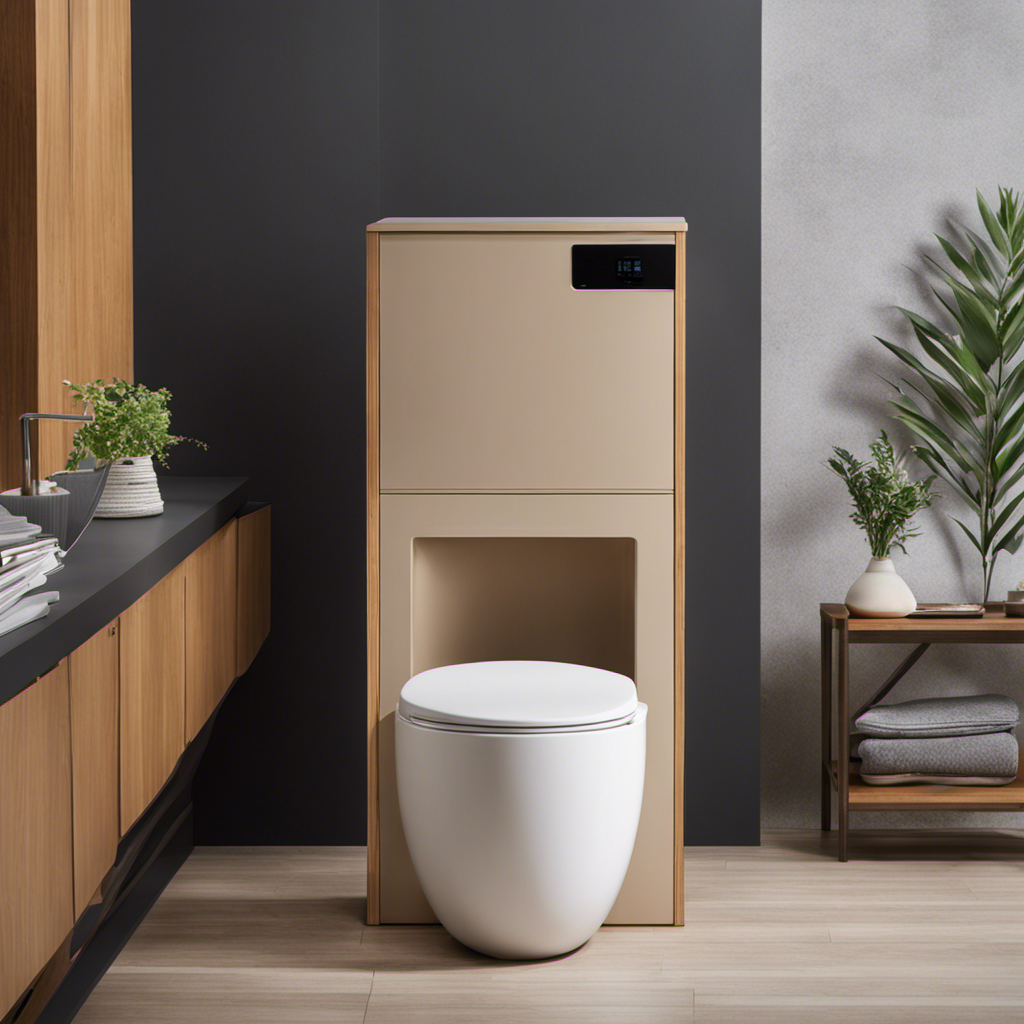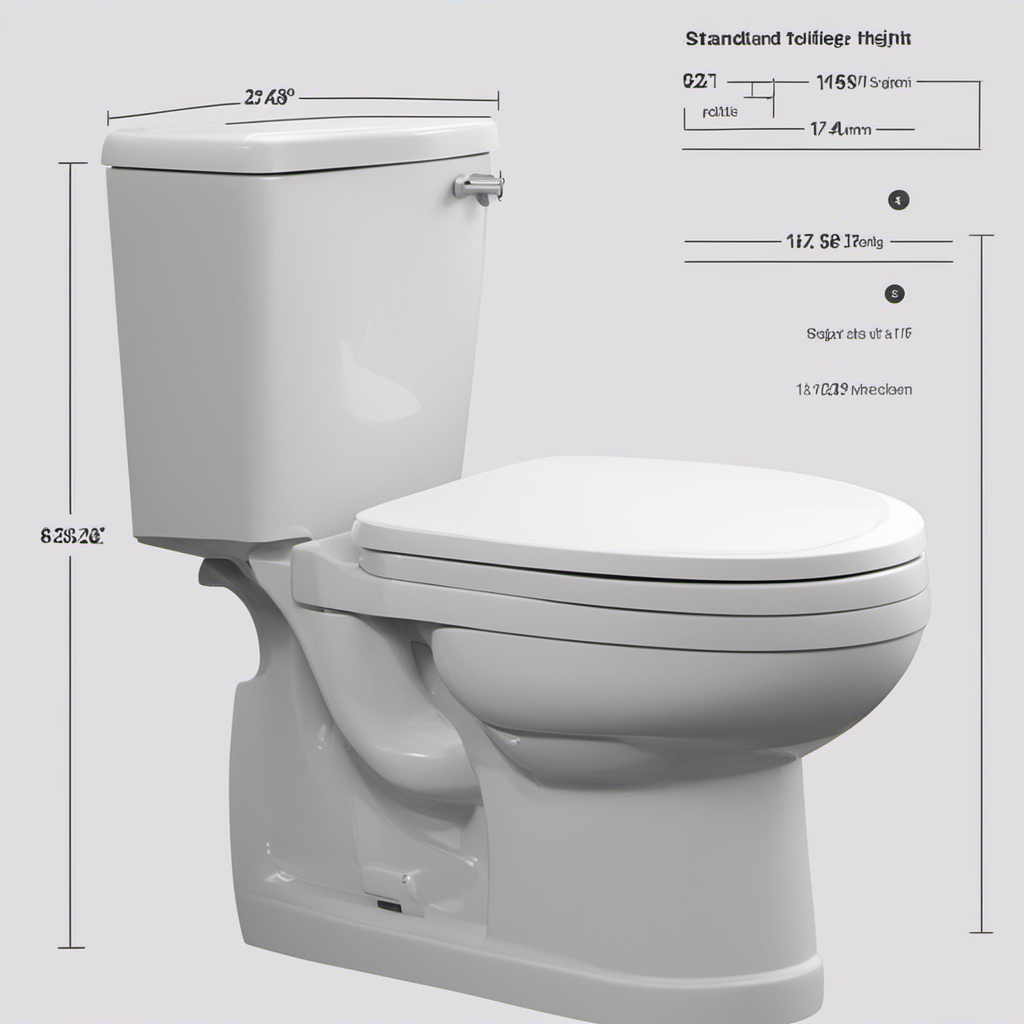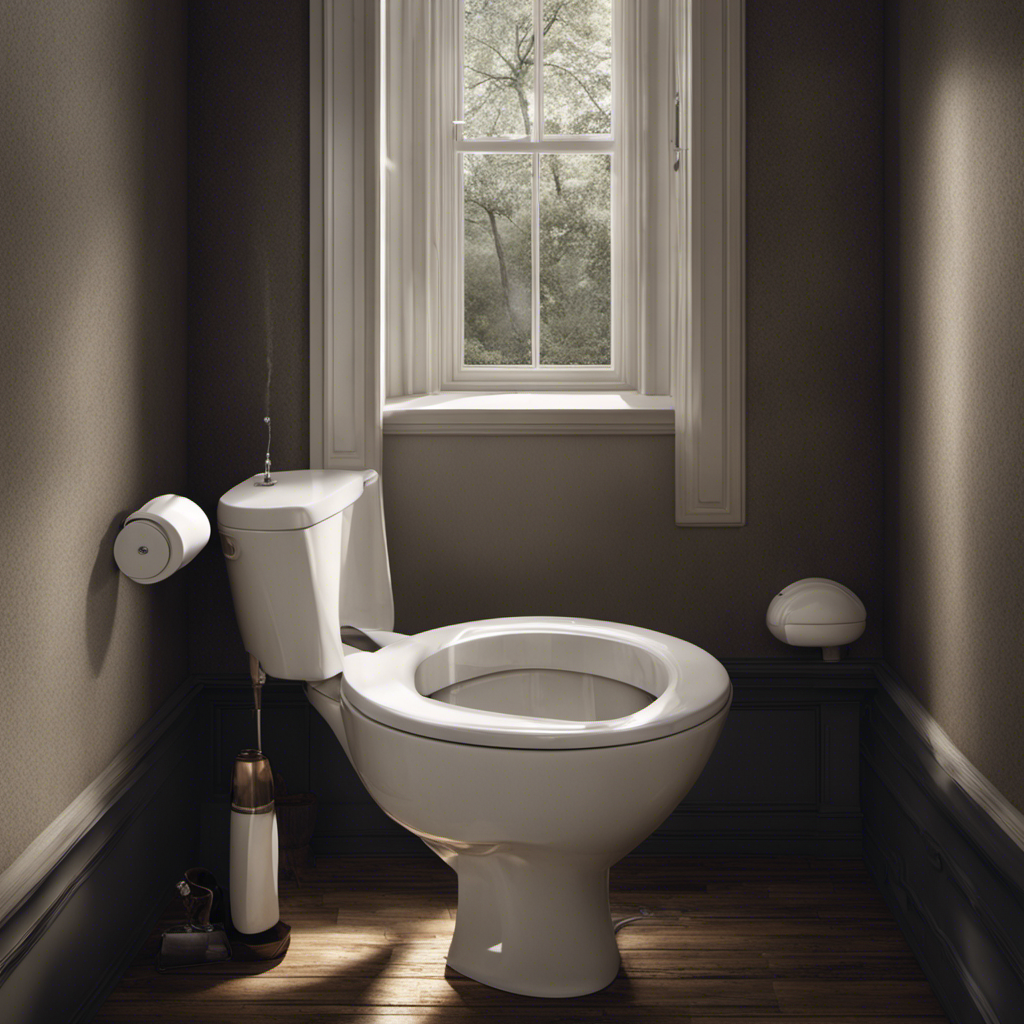As a writer, I’m thrilled to dive into the fascinating world of dry toilets.
Imagine a toilet that doesn’t rely on water, but still offers countless benefits.
In this article, we will explore the inner workings of dry toilets, their various types, and the environmental impact they can have.
By the end, you’ll have a comprehensive understanding of this innovative sanitation solution.
So, let’s roll up our sleeves and embark on this enlightening journey together.
Key Takeaways
- Dry toilets save water and reduce environmental impact.
- They compost human waste into nutrient-rich material.
- Different types of dry toilets include self-contained units, central composting systems, and urine-diverting toilets.
- Effective odor control methods, such as proper ventilation and the use of carbon filters, are crucial for maintaining a pleasant restroom experience.
Benefits of Using a Dry Toilet
Using a dry toilet can save you water and reduce your environmental impact. Waterless toilets, also known as composting toilets, are an innovative solution that eliminates the need for traditional flushing systems.
These toilets operate by composting human waste, transforming it into a nutrient-rich compost material. By doing so, they eliminate the need for water to transport and treat waste, making them an ideal choice for areas with limited water resources or off-grid living.
Composting toilets also contribute to the reduction of greenhouse gas emissions, as the composting process prevents the release of methane gas that occurs in traditional sewage treatment systems. Additionally, the compost produced can be used as a valuable fertilizer, closing the nutrient loop and reducing the need for synthetic fertilizers.
Overall, the use of dry toilets offers a sustainable and eco-friendly alternative to traditional flushing toilets.
How Does a Dry Toilet Work
A dry toilet operates in an odorless and hygienic manner by separating waste and liquid. This technology, also known as composting toilets, utilizes a unique system to break down human waste. When using a dry toilet, the solid waste is directed into a separate chamber or container, while the liquid waste is diverted to a separate area. This separation is crucial in preventing odors and maintaining hygiene.
Inside the solid waste chamber, organic matter such as sawdust or peat moss is added to aid in the decomposition process. Through natural processes such as aerobic bacteria and fungi, the waste is broken down into compost over time. This compost can then be safely used as fertilizer for plants, closing the loop in sustainable waste management.
Different Types of Dry Toilets
When it comes to different types of composting toilets, you have options such as self-contained units, central composting systems, and urine-diverting toilets. Each type has its own unique features and benefits.
Self-contained units: These toilets are all-in-one systems where waste is collected and composted in a single container. They are compact and ideal for small spaces or mobile applications.
Central composting systems: These toilets have a separate composting chamber where waste is collected and processed. They are typically used in larger installations such as campgrounds or eco-villages.
Urine-diverting toilets: These toilets separate urine from solid waste, which helps to prevent odor and allows for more efficient composting. They are a popular choice for both residential and commercial applications.
Regardless of the type, composting toilets are a sustainable and eco-friendly alternative to traditional flush toilets. They help to conserve water, reduce the need for sewage infrastructure, and produce nutrient-rich compost for gardening. Urine diverting toilets, in particular, offer enhanced performance and odor control.
Maintenance and Cleaning of Dry Toilets
When it comes to maintaining and cleaning dry toilets, there are several key points to consider.
First, effective odor control methods are crucial in order to ensure a pleasant restroom experience. This can include using ventilation systems, odor neutralizers, and proper waste management techniques.
Secondly, using eco-friendly cleaning products is not only important for the environment, but also for the overall health and well-being of the users.
Lastly, establishing a regular maintenance schedule is essential to keep the dry toilets in optimal condition, preventing any potential issues or malfunctions.
Odor Control Methods
One way to control odor in a dry toilet is by using ventilation systems. These systems help to remove the foul smells by constantly circulating fresh air and expelling the odorous gases.
Odor control techniques are essential in composting toilets to ensure a pleasant environment for users and efficient decomposition of waste. Here are five effective methods for odor control in dry toilets:
-
Proper ventilation: Install an exhaust fan or use natural ventilation to maintain a continuous flow of fresh air.
-
Carbon filters: These filters absorb and neutralize odors, preventing them from escaping the toilet.
-
Composting process: Efficient composting of waste reduces odor as organic materials break down into stable, odorless compost.
-
Cover materials: Adding sawdust, peat moss, or coconut coir after each use helps to absorb moisture and control odor.
-
Regular maintenance: Emptying the composting chamber and cleaning the toilet regularly prevents the buildup of odorous waste.
Eco-Friendly Cleaning Products
In terms of sustainable waste management, it is crucial to consider the use of eco-friendly cleaning products. These products are specifically designed to minimize the negative impact on the environment and human health.
Eco-friendly cleaning products are formulated using natural ingredients that are biodegradable and non-toxic. They do not contain harsh chemicals such as bleach or ammonia, which can contribute to water pollution and respiratory issues. Instead, they utilize plant-based ingredients that are gentle yet effective in removing dirt, stains, and bacteria.
Additionally, eco-friendly cleaning products often come in recyclable or biodegradable packaging, further reducing waste. By incorporating these products into our cleaning routines, we can contribute to a more sustainable waste management system and promote a healthier environment for both current and future generations.
Regular Maintenance Schedule
Regular maintenance on your car ensures optimal performance and extends its lifespan. To keep your vehicle running smoothly, follow a regular cleaning schedule and perform routine maintenance tasks.
Here are some key maintenance practices to consider:
- Regularly change the oil and oil filter to prevent engine damage.
- Check and replace the air filter to ensure proper air flow and fuel efficiency.
- Inspect and rotate the tires to promote even wear and improve handling.
- Clean the battery terminals and cables to prevent corrosion and ensure a reliable electrical system.
- Keep the exterior and interior of the car clean to protect the paint, upholstery, and overall appearance.
By adhering to a regular maintenance schedule, you can maximize the lifespan of your car and prevent costly repairs in the future.
Now, let’s delve into the environmental impact of dry toilets.
Environmental Impact of Dry Toilets
Water conservation benefits, waste management alternatives, and sustainable sanitation solutions are crucial aspects to consider when discussing the environmental impact of dry toilets.
By utilizing dry toilets, we can significantly reduce water consumption, especially in areas facing water scarcity.
Additionally, waste management alternatives such as composting and anaerobic digestion provide effective ways to convert human waste into valuable resources while minimizing environmental harm.
Lastly, sustainable sanitation solutions encompass innovative technologies and practices that promote hygiene and sanitation without compromising the environment, ensuring a more sustainable future for all.
Water Conservation Benefits
Using a dry toilet can help save water, providing numerous benefits for water conservation. By implementing eco-friendly practices and water-saving solutions, dry toilets contribute to sustainable waste management. Here are some key advantages of using a dry toilet:
- Reduced water consumption: Dry toilets eliminate the need for flushing, saving significant amounts of water.
- Preservation of freshwater resources: By reducing water usage, dry toilets help conserve precious freshwater resources.
- Decreased strain on wastewater treatment systems: With fewer flushes, the burden on wastewater treatment plants is alleviated.
- Enhanced resilience during water scarcity: Dry toilets function independently of water availability, making them reliable during periods of water scarcity.
- Mitigation of pollution: By minimizing the mixing of waste and water, dry toilets prevent the contamination of water sources, protecting ecosystems and public health.
Transitioning to waste management alternatives, let’s explore the various options available.
Waste Management Alternatives
When it comes to waste management alternatives, you have a range of options to consider. One option that stands out is composting toilets.
These toilets are designed to convert human waste into compost, which can then be used as fertilizer. Composting toilets work by providing an environment that promotes the breakdown of organic matter through the action of bacteria and other microorganisms. This process is known as decomposition.
The toilets are equipped with a ventilation system that helps control moisture levels and odor. The biodegradable waste management aspect of composting toilets is crucial as it reduces the amount of waste that ends up in landfills.
Additionally, the compost produced can be used to enrich soil and support plant growth, making composting toilets a sustainable and environmentally friendly solution for waste management.
Sustainable Sanitation Solutions
If you’re looking for an eco-friendly option, one solution to consider for sustainable sanitation is a composting toilet. Composting toilets are designed to break down human waste and convert it into compost that can be used as fertilizer. They offer several advantages over traditional flush toilets, including reduced water consumption, nutrient recycling, energy savings, cost-effectiveness, and community adoption.
Composting toilets require little to no water for flushing, helping to conserve water resources. The compost produced by these toilets can be used as a valuable resource for agriculture, closing the nutrient loop. Additionally, composting toilets do not require electricity or sewage infrastructure, reducing the energy footprint of sanitation systems. They can be a cost-effective option, especially in areas where installing conventional sewage systems is not feasible.
Moreover, composting toilets can promote community involvement in waste management, empowering individuals to take responsibility for their own sanitation needs. Overall, composting toilets offer a sustainable and practical solution to address sanitation challenges while promoting community adoption of environmentally friendly practices.
Considerations Before Installing a Dry Toilet
Before installing a dry toilet, you should evaluate your water usage and waste management needs. Considerations for installation include the availability of a suitable location and the necessary space for the system.
Additionally, you should assess the type of waste you generate and whether it can be safely and effectively managed by a dry toilet. The installation process involves preparing the area, including ensuring proper ventilation and drainage, and selecting the appropriate type of dry toilet system for your needs.
This may include choosing between composting or incinerating systems, depending on factors such as available resources and local regulations. Proper installation is crucial to ensure the functionality and efficiency of the dry toilet system, as well as to prevent any potential health and environmental risks.
Frequently Asked Questions
Are Dry Toilets Suitable for All Types of Households?
Dry toilets, while beneficial for the environment due to reduced water consumption and waste treatment, may not be suitable for all households. Social acceptance and cultural barriers play a role in their adoption.
Can Dry Toilets Be Installed in Urban Areas?
Yes, dry toilets can be installed in urban areas. Although some may question their compatibility with existing urban infrastructure, the water savings they offer make them a viable option for sustainable sanitation.
What Is the Cost of Installing and Maintaining a Dry Toilet?
The cost of installing and maintaining a dry toilet can vary depending on factors such as location and design. However, the environmental benefits, such as water conservation and reduced pollution, make it a worthwhile investment.
Are There Any Health Risks Associated With Using a Dry Toilet?
There may be health risks associated with using a dry toilet, but the benefits of improved sanitation and reduced water usage outweigh them. Plus, it has a positive environmental impact by conserving water resources.
How Does the Odor Control in Dry Toilets Work?
Odor control in dry toilets relies on proper maintenance. Regular removal of waste, ventilation, and the use of absorbent materials help minimize odors. Following these maintenance requirements ensures a more pleasant experience.
Conclusion
In conclusion, dry toilets offer numerous benefits. They conserve water, save money, and control odors. They achieve this by separating liquid and solid waste, enabling composting and recycling. There are different types of dry toilets available, such as composting toilets, incinerating toilets, and bio-digesting toilets. It is crucial to properly maintain and clean these toilets to ensure efficient operation. Dry toilets have a significant positive environmental impact by reducing water usage and pollution. However, before installing one, it is important to consider factors such as space requirements and local regulations. Overall, dry toilets are a sustainable and practical solution for waste management.










